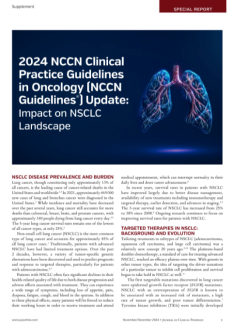Progress and Unmet Needs in Post-IO Treatment for Metastatic RCC
In this interview, Dr Neil Shah discusses the challenges of treatment sequencing for metastatic renal cell carcinoma (mRCC) after immune checkpoint inhibitor therapy, highlighting findings from his study on post-IO treatment efficacy and the need for novel therapeutic options.
Read the full transcript below:
Please introduce yourself by stating your name, title, and any relevant clinical experience.
Neil Shah, MD: I'm Neil Shah. I'm a genitourinary (GU) medical oncologist at Memorial Sloan Kettering Cancer Center. I focus on treatments for GU patients, including patients with kidney cancer, patients with bladder cancer, and patients with prostate cancer.
Given the widespread adoption of PD-1/PD-L1 inhibitors in metastatic renal cell carcinoma (mRCC), what gaps in knowledge about post-immuno-oncology (IO) treatment did you aim to address with this study?
Dr Shah: That's an excellent question. We have made significant strides in the treatment of renal cell carcinoma with several groundbreaking first-line therapies available today, including PD-1-based treatments that have shown remarkable results in controlling the cancer.
However, despite this advancement, some patients' cancer may eventually develop resistance to this therapy and [begin] to grow again. We really wanted to understand what happens here, and the primary goal of our study was to explore the treatments being used after immune checkpoint inhibitors stop working and evaluate their clinical outcomes.
By understanding how patients' cancer responds to these subsequent treatments, we aim to improve care for those who experiences unfortunate progression.
Despite differences in index regimen classes and lines of therapy, the study did not find significant differences in overall survival or real-world progression-free survival. How do you interpret this result?
Dr Shah: This is an excellent but a complex question. As we briefly discussed, there are many newer treatments available, and sequencing them appropriately remains a significant challenge.
We lack significant data on optimal sequencing of these therapies, and, to address this question, we need prospective randomized trials. Given that, we tried to understand what is common practice, especially in US community oncology settings. We found that tyrosine kinase-based treatments, such as cabozantinib, axitinib, and pazopanib, were the most commonly used treatments in this setting.
We also noted that newer treatments were being utilized in this setting. However, these treatments were used in different sequencing and settings, and we did not observe differences in clinical outcome. What does this mean?
This means that we have made excellent progress, but we still need to understand treatment sequencing better. The good thing about this study is that it shows that despite choosing different sequencing, most of the patients [have] similar [outcomes]. We do not see any major differences if you choose one drug vs another combination, which is very reassuring for the patients.
Eventually, we'll need some of the newer treatments in this space and to really understand if we do X followed by Y vs Y followed by Z, [what is] best? I think that those are really difficult questions to answer. However, overall, our study shows that it doesn't matter which you choose, most of the treatments are effective and work well in the post-immunotherapy setting.
How should these findings inform treatment sequencing decisions for patients with mRCC who progress on initial IO therapy?
Dr Shah: This is the million-dollar question. For our patients, unfortunately, who experience progression on first-line or even subsequent-line IO-based treatment, what do you do and how do you do it?
This remains a significant challenge. Findings from our study suggest that as long as you're using US Food and Drug Administration (FDA)-approved agents in various settings, this seems to be helpful, and there's no major difference in how you use one agent vs another agent as long as you are using an FDA-approved agent. Overall, findings from our study are very reassuring for our clinicians and patients, as we have many treatment options available. We did not identify whether one way is the right way, but what we noticed is that [we can use treatments] in different ways and getting them to the patients is most important.
What role do you see for novel therapies or combination approaches in improving post-IO outcomes?
Dr Shah: Very important question. Is there a need, in a post-IO setting, for novel agents? Findings from our studies suggest that, unfortunately, despite having many treatment options and treatment sequencing options available for our patients, the majority of patients will eventually need subsequent treatment.
There is a definite need for newer agents in this space. We also need agents with different mechanisms of action because a lot of times patients who have used immune checkpoint inhibitors or tyrosine kinase inhibitors (TKIs) experience some side effects and sometimes they are not able to continue those drugs. However, we now have newer drugs with different mechanisms of action, such as, most recently, belzutifan or HIF-2α inhibitors. These are a newer class of drug and have a different side effect profile. This is very encouraging right now in the market, and we look forward to many more similar and newer agents with different mechanisms of action in this space.
Is there anything else you’d like our audience to take away from this study?
Dr Shah: For my overall summary, I would say that we have made significant progress in treating kidney cancer with new first-line therapies, including PD-1-based treatment, tyrosine kinase-based treatments, but resistance remains a challenge.
Our study examines the current use of post-IO treatments, especially in US community oncology settings, where TKI-based treatments are the most common treatments. Overall, we observed the increased utilization of newer treatments, which is really encouraging for our patients and our clinicians. However, we do need agents with different and newer mechanisms of action and different toxicities in this space.

















